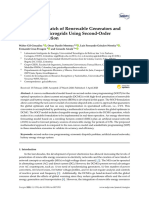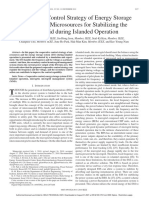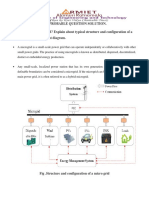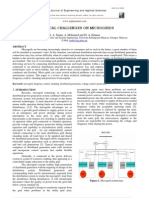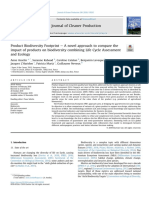Optimal Management of Micro Grid in Restructured Environment
Optimal Management of Micro Grid in Restructured Environment
Uploaded by
Ahmed HussainCopyright:
Available Formats
Optimal Management of Micro Grid in Restructured Environment
Optimal Management of Micro Grid in Restructured Environment
Uploaded by
Ahmed HussainOriginal Title
Copyright
Available Formats
Share this document
Did you find this document useful?
Is this content inappropriate?
Copyright:
Available Formats
Optimal Management of Micro Grid in Restructured Environment
Optimal Management of Micro Grid in Restructured Environment
Uploaded by
Ahmed HussainCopyright:
Available Formats
2012 Second Iranian Conference on Renewable Energy and Distributed Generation
Optimal Management of Micro Grid in Restructured
Environment
Ehsan Nasrolahpour*, Meysam Doostizadeh*, Hassan Ghasemi*, Senior member, IEEE
*School of Electrical and Computer Engineering
*University of Tehran
*Tehran, Iran
Emails: e.nasrolahpour@ece.ut.ac.ir, m.doostizadeh@ece.ut.ac.ir, h.ghasemi@ut.ac.ir
AbstractElectric utility deregulation and power system
restructuring encourage micro grids penetration into distribution
networks. Micro grids are low voltage distribution networks that
are designed to supply electric and heat loads for small
communities. A micro grid which is aggregation of various
distributed generators (DGs), storage devices and controllable
loads, can be operated and dispatched flexibly. Micro grids can
work in an interconnected or autonomous mode. In this paper,
component models of micro grids are determined by using real
data and cost of micro grid is minimized in order to determine
the optimal generation of each DG and the amount of
controllable loads during a day. The problem formulation
includes purchased energy from the main grid, DGs operational
cost, start-up and shut-down costs, and finally the cost of
interrupted loads. Also, the ramp rate and other constrains of
each DG are considered. The micro gird considered in this paper
consists of a wind turbine, a micro turbine, a photovoltaic array
and a fuel cell.
Micro grids can provide energy at lower price because of
their optimal use of waste heat. In addition, they do not pay any
cost for congestion, customer service, distribution and
transmission losses and other costs unlike traditional power
systems. The generation of micro grid should be changed with
regards to the variation of grids energy price. For better
performance, we need to manage and control the micro grid.
A successful management of micro grid must provide a
strong financial incentive for both micro grid owners and the
main gird. In order to manage micro grids, the following
information should be known as input data:
The energy price of main grid at any time
Maximum amount of interruptible load
All characteristics related to DGs such as wind speed,
temperature, irritation and etc.
Keywords- micro grid; component model; DG; energy
management.
Many studies have been done in the area of micro grids,
which some of them deal with optimization of micro grid
operation. Decentralized control of micro grid is discussed in
[4]. Ref. [5] suggested centralized control strategy. [6]
optimizes the operation of a micro grid at only 1 hour and in an
autonomous mode. In [7] optimizing the operation of an
autonomous micro grid is performed in 24 hours of a day but it
is done separately for each hour and there is no link between
them. [8] uses the model of [5] and optimizes the operation of
micro grid in 24 hours by using the genetic algorithm but the
component models of micro grid are not considered. In [9] the
cost function is minimized by MADS (Mesh Adaptive Direct
Search), but MADS alone is not sufficient to reach an optimal
solution, so MADS needs to be combined with SQP
(Sequential Quadratic Programming) to reach the optimal
solution and it should be considered too that MADS and SQP
methods are inherently unable to result in a global solution
[10]. The present paper proposes the component model of
micro grid, then develops the model of [5] and optimizes the
operation of the system considering constrains of network and
DGs. The objective function includes the purchased energy
from the main grid, DGs operational cost, start-up and shutdown costs, and finally the cost of interrupted loads. For
problem solution, the GAMS software is employed.
I.
INTRODUCTION
The need for more flexible and accessible electrical
systems, enhancement of local reliability, environmental and
economical issues derive development of micro grids, which
surely will play a significant role in the future of power system.
Micro grids are defined as intelligent distribution networks
include various distributed generators, storage devices and
controllable loads [1]. Micro grid can be operated in
autonomous mode in condition that it is disconnected from the
main grid or in non-autonomous mode if it is connected to the
main grid. A non-autonomous micro grid, due to its connection
to power utilities, can reach greater controllability and stability.
From the grids point of view, a micro grid is a controlled
entity that can be operated as a single aggregated load and as a
small source of power or ancillary services supporting the
network. On the other hand, micro grids are similar to
traditional local distribution networks that provide electricity,
from the customers point of view [2]. Since the micro grids
are designed to generate power at the voltage level of
distribution networks, they have limited energy handling
capability. Therefore, their maximum capacity is normally
restricted to 10 MVA [3].
978-1-4673-0665-2/12/$31.00 2012 IEEE
116
C.
Fuel Cell Cost
Fuel cell converts the chemical energy into electrical
energy. The following is the function used to calculate the cost
of fuel cell.
This paper is organized as follows: The components model
is discussed in section II. In section III, the objective function
and the constraints of problem are described. The case study is
introduced in section IV. The simulation results are presented
in section V. Finally, the section VI concludes the paper.
(5)
Pj
II. MICRO GRID COMPONENT
Different types of DG technologies have been invented
which are utilized in distribution networks. The output power
of DG in each technology depends on various parameters such
as environmental conditions. In this part, the output power of
each type has been modeled as a function of their input
parameters [9].
where Cnl is the natural gas price; Pj shows the net electrical
power produced at interval j; nj represents the cell efficiency at
interval j.
A.
D.
C fc (t ) = C nl .
Micro Turbines Cost
Micro turbines are widely used in DG systems and as
energy producer in CHP (Combined Heat and Power) systems.
They are small and simple-cycle gas turbine. Micro turbine can
be modeled as fuel cells. The cost of micro turbine can be
expressed as:
Wind Turbine
Wind turbine converts wind energy into electrical one. The
output power of a wind turbine depends on several factors such
as availability of the wind, the wind turbine power curve, wind
speed, size and shape of turbine. The power developed is given
by (1) [11]:
0
Pwt (t ) = a.v(t )3 b.PR
P
R
v < vci , v > vco
vci < v < vr
vr < v < vco
(6 )
Pj
(1)
C mt (t ) = C nl .
OPTIMIZATION PROBLEM
III.
where Pwt and PR denote actual and rated power, respectively; v
and vt are actual and rated wind speed, respectively; vci and vco
present cut-in and cut-off wind speed, respectively; a and b are
obtained from following equations:
b=
a=
vr3
A.
Min.
vci3
OC =
p .P
t
t =1:24
pR
vr3 vci3
Gstc
(1 + k (Tc Tr ))
(C
dg,t .Pdg,t .wdg,t
(7 )
t =1:24 dgS
IL ( PIL,t )
t =1:24
where pt denotes the energy price of main grid; Pgrid,t is the
amount of power exchanged between main grid and micro
grid; Cdg,t represents generation cost of each DG in each hour;
Pdg,t is generation of each DG in each hour; wdg,t ,udg,t ,vdg,t are
binary values that denote commitment status, start up, shut
down cost of each DG in each hour; STCdg and SHCdg indicate
start up and shut down cost; pIL is cost of interruptible load,
PIL,t correspond to amount of interruptible load; S is set of
DGs.
Photovoltaic
Solar PV generates the electricity from free solar energy.
The output power of this module can be calculated as follows:
Ging
grid,t
STCdg .udg,t + SHCdg .vdg,t ) +
(3)
B.
Ppv = Pstc
Obective Function
In order to minimize operation cost and therefore,
maximize social welfare the objective function is defined as
below:
(2)
vci3
(4)
where Ging and Gstc indicate irradiance at actual time and
standard situation, respectively. Gstc is supposed as 1000
(w/m2); Tc and Tr corresponding to cell temperature and
reference temperature, respectively; k is thermal coefficient of
photovoltaic; Ppv and Pstc denote the output power and the
module maximum power at standard test condition (STC),
respectively.
B.
Constraints
The problem constraints such generation limits and
capacity reserve limits are formulate as follows:
1- The supply-demand balancing constraint:
117
Pgrid ,t +
dg ,t
= PD (t ) Pcurt,t
t = 1 : 24
(8)
dgS
2- DG constraints:
Pdg ,t , min Pdg ,t .wdg , t Pdg , t , max t = 1 : 24
(9)
Pdg , t +1 Pdg ,t Rumdg
t = 1 : 24
(10)
Pdg , t Pdg , t +1 Rdmdg
t = 1 : 24
(11)
[Ton,dg,t MUTdg ].[wdg,t1 wdg,t ] 0
t = 1: 24 dg S
(12)
[Toff,dg,t MDTdg ].[wdg,t1 wdg,t ] 0 t =1: 24 dgS
(13)
[ wdg , t wdg , t 1 ] udg , t
(14)
t = 1 : 24 dg S
[ wdg , t wdg , t 1 ] vdg ,t
t = 1 : 24 dg S
Figure 1. Study case LV network [3]
(15)
Figure 2.
[wdg,t wdg,t 1 ] udg,t vdg,t t = 1 : 24 dg S
(16)
Two scenarios are described for energy price of main grid
as shown in Fig. 2. Also, for each scenario two strategies is
considered.
where Pdg,t,min and Pdg,t,max represent the minimum and
maximum generation of each DG in each hour, repectively;
Rumdg and Rdmdg are the ramp up and ramp down limit of each
DG; Ton,dg,t and Toff,dg,t denote the on and off times of each DG,
respectively; MUTdg and MDTdg are minimum up and down
limits of each DG, respectively.
Strategy 1: micro grid can buy energy from main grid but
cannot sell energy to the grid.
Strategy 2: micro grid can exchange power with the main
grid freely and can sell energy to main grid.
3- The constrains of interruptible load:
0 Pcurt m PD
V. RESULTS
The result of simulation has been shown in below figures. It
should be noted that since energy price are different in two
scenarios, demand of the network differ in each scenario. As it
can be seen for the presented results, at the hours that the
energy price of main grid is high, the majority of load demand
is provided by DG units of micro grid.
(17)
where m is the maximum of interruptible load.
Also, at hours that the DGs operational costs are higher than
the energy price, DG units reduce their power generation and
the energy is mostly injected from the grid into micro grid to
diminish total cost of system.
4- Reserve capacity:
dg ,t ,max wdg ,t
+ Pgrid,t + Pcurt,t = Res
(18)
dgS
Furthermore, at pick load hours that the load demand is
more than the generable energy by DGs, and the energy price
of grid is too high, some part of controllable loads are
interrupted so that the system total cost be reduced.
where Res denotes the reserve capacity of micro grid.
IV.
Wholesale market price
CASE STUDY
Since the generation cost of micro turbine and fuel cell is
low in comparison to other DGs, and also their generated
power is independent from environmental conditions, thus,
most of the generated energy by DGs is dedicated to them.
A.
System Description
The micro grid shown in Fig. 1 is used as the test case,
which consists of photovoltaic array, a wind turbine, a fuel cell
and one micro turbine. The characteristics of above
components are given in Tables A. I-III.
Table I compares the total cost of system in two strategies
and two scenarios. As seen, in each scenario, the cost of
strategy 2 is lower than that of strategy 1. This can be
118
concluded from the fact that in scenario 2, DG units after
meeting the load demand, they can sell their extra energy to the
main grid so that all their capacity is utilized.
reason for this matter is that in the second scenario, the
cheapness of wholesale market energy is continued for more
hours than that for first scenario (see Fig. 2).
VI. CONCLUSION
Based on component model of distributed energy
resources, environmental conditions, energy price of main
grid, maximum amount of interruptible load and other
constraints related to the system, this paper proposes
optimization and dispatch model of micro grids. The proposed
model is validated by simulation of a micro grid by GAMS
software. The simulation results are discussed in different
interactive operational control strategies and market prices.
The results have verified the effectiveness of the control and
management method in optimized operation of micro grids.
Figure 3. First senario and first strategy
APPENDIX
Figure 4. First senario and second strategy
Figure A.1 Wind speed during a day
Figure 5. Second senario and first strategy
Figure A.2 Sun irritation during a day
Figure 6. second senario and second strategy
Table I. total system cost in different strategies and scenarios
Strategy 1
Strategy 2
First scenario
248.081 ()
226.472 ()
Second scenario
169.063 ()
131.591 ()
Figure A.3 Temperature during a day
Also, it is observed that in each strategy, total system cost
in the second scenario is less than that of first scenario. The
119
Table A.I Wind turbine specifications
[2]
VR (m/s)
13.8
PR (kW)
300
Vci (m/s)
3.1
Vco (m/s)
25
T. Logenthiran, D. Srinivasan, A. M. Khambadkone, Multi-agent
system for energy resource scheduling of integrated microgrids in a
distributed system, Electric Power Systems Research, vol. 81, pp. 138148, Jan. 2011.
[3] R. Lasseter, A. Akhil, C. Marnay, H. Stephens, J. Dagle, R. Guttromson,
A.S. Meliopoulous, R. Yinger, J. Eto, The CERTS Microgrid Concept,
White Paper for CERTS, 2002.
[4] A. L. Dimeas, N. D. Hatziargyrious, Operation of a multiagent system
for microgrid control, IEEE Trans. Power Syst., vol.20, no.3, pp. 1447
1455, Aug. 2005.
[5] A. G. Tsikalakis, N. D. Hatziargyriou, Centralized control for
optimizing microgridsoperation, IEEE Trans. Energy Conv. vol.23,
no.1, pp. 241-248, Mar.2008.
[6] C.A. Hernandez-Aramburo, T.G. Green, N. Mugniot, Fuel consumption
minimizationof a microgrid, IEEE Trans. Ind. Appl., vol 41, no.3, pp.
673681, May 2005.
[7] F.A. Mohamed, H.N. Koivo, System modeling and online optimal
management of microgrid using multiobjective optimization,
International Conference on Clean Electrical Power, Capri, Italy, May
2007.
[8] E. Mashhour, S.M. Moghaddas-Tafreshi, Integration of disributed
energy resources into low voltage grid: A market-based multiperiod
optimization model, Electric Power System Research. vol.80, pp. 473480, Apr. 2010.
[9] F. A. Mohamed, Heikki N. Koivo System modelling and online optimal
management of Micro grid using Mesh Adaptive Direct search
Electrical Power and Energy Systems. vol. 32, pp.398-407, Jun. 2010.
[10] R. Bhuvaneswari, C. S. Edrington, D. A. Cartes, S.Subramanian,
Online Economic Environmental Optimization of a Micro grid Using
an Improved Fast Evolutionary, North American Power Simposium
(NAPS), 2009.
[11] R. Belfkira, G. Barakat, C. Nichita Sizing optimization of a stand-alone
hybrid power supply unit: wind/PVsystem with battery storage,
International Review of Electrical Engineering (IREE) vol. 3, no. 5,
Mar. 2008.
Table A.II Photovoltaic panel specification
Irritation at (stc)
1000
Termal coefficient
-0.004
Enviroment temperature ( c)
25
Table A.III Installed DG sources
Unit ID
Min power (kw)
Max power (kw)
MT
30
FC
30
WT
15
PV1
13
REFERENCES
[1]
N. W. A. Lidula, A. D. Rajapakse, Microgrids research: A review of
experimental microgrids and test systems, Renewable and Sustainable
Energy Reviews, vol. 15, pp. 186-202, Jan. 2010.
120
You might also like
- EDocument66 pagesEAhmed Hussain100% (1)
- Energy Efficient Microgrid Management Using Model Predictive ControlDocument6 pagesEnergy Efficient Microgrid Management Using Model Predictive ControlRas PqrNo ratings yet
- Economic Dispatch of Renewable Generators and BESS in DC Microgrids Using Second-Order Cone OptimizationDocument15 pagesEconomic Dispatch of Renewable Generators and BESS in DC Microgrids Using Second-Order Cone Optimizationcawiti5575No ratings yet
- Overview of Microgrid SystemDocument24 pagesOverview of Microgrid Systemdoud98No ratings yet
- Hatziargyriou 等 - 2011 - Quantification of economic, environmental and operDocument21 pagesHatziargyriou 等 - 2011 - Quantification of economic, environmental and operlifeline11911444No ratings yet
- Article Management Energie BellmanDocument10 pagesArticle Management Energie BellmanYOUNESS ATIFINo ratings yet
- Stability Improved in Micro Grid With Energy Storage Systems Using Cascaded ConverterDocument4 pagesStability Improved in Micro Grid With Energy Storage Systems Using Cascaded Convertermonicaeee33No ratings yet
- Optimal Energy Management of Microgrid Systems in Taiwan: Yen-Haw Chen, Yen-Hong Chen, Ming-Che HuDocument9 pagesOptimal Energy Management of Microgrid Systems in Taiwan: Yen-Haw Chen, Yen-Hong Chen, Ming-Che HuPervez AhmadNo ratings yet
- Control and Protection of Power Electronics Interfaced Distri-Buted Generation Systems in A Customer-Driven MicrogridDocument8 pagesControl and Protection of Power Electronics Interfaced Distri-Buted Generation Systems in A Customer-Driven MicrogridHedra GirgisNo ratings yet
- 11 Economic Dispatch of Micro-Grid Based On IPSODocument6 pages11 Economic Dispatch of Micro-Grid Based On IPSOMuhammad RidhwanNo ratings yet
- Energy: Phillip Oliver Kriett, Matteo SalaniDocument10 pagesEnergy: Phillip Oliver Kriett, Matteo SalaniVishnuTej VinjamuriNo ratings yet
- Economic Power Dispatch of Distributed Generators in A Grid-Connected MicrogridDocument8 pagesEconomic Power Dispatch of Distributed Generators in A Grid-Connected MicrogridAlamson SitanggangNo ratings yet
- International Journal of Advanced Research in Computer Science and Software EngineeringDocument5 pagesInternational Journal of Advanced Research in Computer Science and Software Engineeringdoud98No ratings yet
- Icoa 2018 8370517Document6 pagesIcoa 2018 8370517Kamal BoujaghamaNo ratings yet
- Microgrid Analysis Using HOMER: A Case Study: David Restrepo, Bonie Restrepo-Cuestas & Adriana TrejosDocument6 pagesMicrogrid Analysis Using HOMER: A Case Study: David Restrepo, Bonie Restrepo-Cuestas & Adriana TrejosNelson Andres Entralgo MaldonadoNo ratings yet
- Energy Management of Renewable Energy Sources Incorporating With Energy Storage DeviceDocument17 pagesEnergy Management of Renewable Energy Sources Incorporating With Energy Storage DeviceInternational Journal of Power Electronics and Drive SystemsNo ratings yet
- Microgrid Dynamic Performance Improvement Using A Doubly Fed Induction Wind GeneratorDocument9 pagesMicrogrid Dynamic Performance Improvement Using A Doubly Fed Induction Wind GeneratorDhinesh BaluNo ratings yet
- Community Microgrid: Control Structure, Design, and StabilityDocument9 pagesCommunity Microgrid: Control Structure, Design, and Stabilitycongduy0908No ratings yet
- Coordination of Operational Planning and Real-Time Optimization in MicrogridsDocument9 pagesCoordination of Operational Planning and Real-Time Optimization in MicrogridsM8ow6fNo ratings yet
- Load Frequency Control of Multi-Microgrid System Considering Renewable Energy Sources Using Grey Wolf OptimizationDocument21 pagesLoad Frequency Control of Multi-Microgrid System Considering Renewable Energy Sources Using Grey Wolf Optimizationsuresh_velamuriNo ratings yet
- A State of The Art of DC Microgrids For Electric Vehicle ChargingDocument6 pagesA State of The Art of DC Microgrids For Electric Vehicle ChargingMarco ParedesNo ratings yet
- Economic Dispatch For A Microgrid Considering Renewable Energy Cost FunctionsDocument7 pagesEconomic Dispatch For A Microgrid Considering Renewable Energy Cost FunctionsibtihalislamNo ratings yet
- Optimal Generation Scheduling Strategy in A MicrogridDocument6 pagesOptimal Generation Scheduling Strategy in A MicrogridluciantomaNo ratings yet
- Micro-Grid Simulation During Grid-Connected and Islanded Modes of OperationDocument6 pagesMicro-Grid Simulation During Grid-Connected and Islanded Modes of OperationNguyễn Đức NguyệnNo ratings yet
- Simulation Model of A Permanent Magnet Synchronous Generator For Grid StudiesDocument6 pagesSimulation Model of A Permanent Magnet Synchronous Generator For Grid StudiesRupesh Arun KumarNo ratings yet
- Choice of Power Factor Corrector For Effective Operation of Microgrid and Its ElementsDocument5 pagesChoice of Power Factor Corrector For Effective Operation of Microgrid and Its ElementsJitender KaushalNo ratings yet
- Modelling and Design of PID Controller For Voltage Control of AC Hybrid Micro-GridDocument9 pagesModelling and Design of PID Controller For Voltage Control of AC Hybrid Micro-GridRevit Mep Khoa Đ-đtspktNo ratings yet
- Experimental Test Bench For Testing DC Microgrid Control StrategiesDocument6 pagesExperimental Test Bench For Testing DC Microgrid Control StrategiesdsjfbadsufcbsdubdsuNo ratings yet
- Hil of Battery Less Hybrid SystemsDocument6 pagesHil of Battery Less Hybrid SystemsSourab SomasundarNo ratings yet
- Despacho Económico para La Gestión Óptima de Microrredes AisladasDocument6 pagesDespacho Económico para La Gestión Óptima de Microrredes AisladasHernan TapiaNo ratings yet
- Modeling and Control of Microgrid: An OverviewDocument20 pagesModeling and Control of Microgrid: An OverviewShad RahmanNo ratings yet
- Demand Side Management in A Microgrid To Reduce The Peak Consumption CostDocument8 pagesDemand Side Management in A Microgrid To Reduce The Peak Consumption CostInternational Journal of Power Electronics and Drive SystemsNo ratings yet
- Dynamic Model Microturbine: of Generation System For Grid Connected/Islanding OperationDocument6 pagesDynamic Model Microturbine: of Generation System For Grid Connected/Islanding OperationMahinder ChoudharyNo ratings yet
- Optimal Energy Management For Microgrids With Combined Heat and Power (CHP) Generation, Energy Storages, and Renewable Energy SourcesDocument18 pagesOptimal Energy Management For Microgrids With Combined Heat and Power (CHP) Generation, Energy Storages, and Renewable Energy Sourcesyiğit_ÖksüzNo ratings yet
- Optimal Storage Capacity Within An Autonomous Micro Grid With A High Penetration of Renewable Energy SourcesDocument4 pagesOptimal Storage Capacity Within An Autonomous Micro Grid With A High Penetration of Renewable Energy SourcesPervez AhmadNo ratings yet
- (2010) Cooperative Control Strategy of Energy Storage System and Microsources For Stabilizing The Microgrid During Islanded OperationDocument12 pages(2010) Cooperative Control Strategy of Energy Storage System and Microsources For Stabilizing The Microgrid During Islanded Operationabc1231234454252452342No ratings yet
- Alireza 2014Document9 pagesAlireza 2014AmirKhanNo ratings yet
- A MPPT Strategy Based On Cuckoo Search For Wind enDocument6 pagesA MPPT Strategy Based On Cuckoo Search For Wind enbensumbbNo ratings yet
- 7 ExpDocument9 pages7 ExpSuRaJ BroNo ratings yet
- MG Probable Question SolutionDocument7 pagesMG Probable Question SolutionGYANA RANJANNo ratings yet
- EE552 Power Electronics Project ReportDocument17 pagesEE552 Power Electronics Project ReportMashood NasirNo ratings yet
- MicrogridDocument6 pagesMicrogridracava5627No ratings yet
- Kamasdjhasgaeg PDFDocument10 pagesKamasdjhasgaeg PDFgag aaNo ratings yet
- Defining Control Strategies For MicroGrids Islanded OperationDocument9 pagesDefining Control Strategies For MicroGrids Islanded OperationNaveen AmarasingheNo ratings yet
- Technical Challenges On MicrogridsDocument6 pagesTechnical Challenges On Microgridsmalini72No ratings yet
- 1 Cost ModelsDocument10 pages1 Cost ModelsjameelahmadNo ratings yet
- Multi-Objective Optimal Dispatching of Microgrid With Large-Scale Electric VehiclesDocument9 pagesMulti-Objective Optimal Dispatching of Microgrid With Large-Scale Electric VehiclesAli HussienNo ratings yet
- Article TextDocument15 pagesArticle TextTanishNo ratings yet
- Microgrids - An Integration of Renewable Energy TechnologiesDocument7 pagesMicrogrids - An Integration of Renewable Energy TechnologiesSheikh SaddamNo ratings yet
- Operation Planning of A Smart Microgrid Including Controllable Loads and Intermittent Energy Resources by Considering UncertaintiesDocument19 pagesOperation Planning of A Smart Microgrid Including Controllable Loads and Intermittent Energy Resources by Considering UncertaintieskesavantNo ratings yet
- Ijaerv13n21 08Document7 pagesIjaerv13n21 08Kamran AhmedNo ratings yet
- On&Off-Grid Hybrid Microgrid Design and Dynamic Analysis: Umit Cetinkaya Ramazan BayindirDocument5 pagesOn&Off-Grid Hybrid Microgrid Design and Dynamic Analysis: Umit Cetinkaya Ramazan BayindirSakina ZaidiNo ratings yet
- Control Buck Boost Converters ForStand-Alone DC Microgrids ConferenceDocument9 pagesControl Buck Boost Converters ForStand-Alone DC Microgrids Conferenceaiam gorengNo ratings yet
- IJEEE - Microgrid BSS Scheduling Using Teaching Learning Based Optimization AlgorithmDocument11 pagesIJEEE - Microgrid BSS Scheduling Using Teaching Learning Based Optimization Algorithmiaset123No ratings yet
- A Microgrid Multilayer Control Concept For Optimal Power Scheduling and Voltage ControlDocument10 pagesA Microgrid Multilayer Control Concept For Optimal Power Scheduling and Voltage ControlSumit RathorNo ratings yet
- A_Multi-Level_Control_and_Optimization_Scheme_for_Islanded_PV_Based_Microgrid_A_Control_Frame_WorkDocument10 pagesA_Multi-Level_Control_and_Optimization_Scheme_for_Islanded_PV_Based_Microgrid_A_Control_Frame_Workprabhakarkumargupta92No ratings yet
- 10.1109-JSYST.2013.2296075-Control Methods and Objectives For Electronically Coupled Distributed Energy Resources in Microgrids - A ReviewDocument13 pages10.1109-JSYST.2013.2296075-Control Methods and Objectives For Electronically Coupled Distributed Energy Resources in Microgrids - A Reviewarashalavi2006No ratings yet
- Use of Renewable Energy Sources in University Campus Microgrid - A ReviewDocument8 pagesUse of Renewable Energy Sources in University Campus Microgrid - A ReviewAkindeji Kayode TimothyNo ratings yet
- Energy and Thermal Management, Air-Conditioning, and Waste Heat Utilization: 2nd ETA Conference, November 22-23, 2018, Berlin, GermanyFrom EverandEnergy and Thermal Management, Air-Conditioning, and Waste Heat Utilization: 2nd ETA Conference, November 22-23, 2018, Berlin, GermanyChristine JuniorNo ratings yet
- A Case Study for a Single-Phase Inverter Photovoltaic System of a Three-Bedroom Apartment Located in Alexandria, Egypt: building industry, #0From EverandA Case Study for a Single-Phase Inverter Photovoltaic System of a Three-Bedroom Apartment Located in Alexandria, Egypt: building industry, #0No ratings yet
- 7SR191 - Technical Manual R2e-1aDocument417 pages7SR191 - Technical Manual R2e-1aAhmed HussainNo ratings yet
- (Job Title) (Date) .: ResignationDocument1 page(Job Title) (Date) .: ResignationAhmed HussainNo ratings yet
- 7PG1903 B3 Catalogue Sheet PDFDocument5 pages7PG1903 B3 Catalogue Sheet PDFAhmed HussainNo ratings yet
- IESCODocument4 pagesIESCOAhmed HussainNo ratings yet
- Electromagnetic Transients Simulation As An Objective Function Evaluator For Optimization of Power System PerformanceDocument6 pagesElectromagnetic Transients Simulation As An Objective Function Evaluator For Optimization of Power System PerformanceAhmed HussainNo ratings yet
- Neural Networks Give A Warm Start To Linear Optimization ProblemsDocument6 pagesNeural Networks Give A Warm Start To Linear Optimization ProblemsAhmed HussainNo ratings yet
- Engineering Ethics: General PrinciplesDocument6 pagesEngineering Ethics: General PrinciplesAhmed HussainNo ratings yet
- Chapter 08 (Electronic Devices and Circuits-II)Document59 pagesChapter 08 (Electronic Devices and Circuits-II)Ahmed HussainNo ratings yet
- Chapter 12 (Electronic Devices and Circuits-II) (1) FinalDocument50 pagesChapter 12 (Electronic Devices and Circuits-II) (1) FinalAhmed HussainNo ratings yet
- Will Magnetic Shield Block The Fields EffectsDocument1 pageWill Magnetic Shield Block The Fields EffectsAhmed HussainNo ratings yet
- Investasi Panas Bumi-PLNDocument52 pagesInvestasi Panas Bumi-PLNK3 ULPLTOBELONo ratings yet
- Light of The World PrintingDocument25 pagesLight of The World Printinggeorge robertNo ratings yet
- Case Study No. 02Document5 pagesCase Study No. 02Fatimae PalermoNo ratings yet
- Colegio San Agustin-Mati, Inc.: Teaching GuideDocument17 pagesColegio San Agustin-Mati, Inc.: Teaching GuideGonzalo balusca100% (1)
- DES211 Environment and Sustainable DevelopmentDocument179 pagesDES211 Environment and Sustainable DevelopmentElhadj TIRNo ratings yet
- Tourism Policies and InitiativesDocument5 pagesTourism Policies and InitiativesmanjuNo ratings yet
- Project SynopsisDocument4 pagesProject SynopsisShreya DGNo ratings yet
- 1 s2.0 S0740624X12001487 MainDocument16 pages1 s2.0 S0740624X12001487 MainAres GilesNo ratings yet
- Heating Water SystemDocument1 pageHeating Water SystemDeepak SharmaNo ratings yet
- BIG DATA - Final Report - File WordDocument74 pagesBIG DATA - Final Report - File WordPhạm Nguyên QuânNo ratings yet
- Emblemsvag - Reengineering Capitalism From Industrial Revolution Towards Sustainable Development (2016)Document325 pagesEmblemsvag - Reengineering Capitalism From Industrial Revolution Towards Sustainable Development (2016)wolfgang.villarreal2984No ratings yet
- Floating Foundations For Offshore Wind TurbinesDocument37 pagesFloating Foundations For Offshore Wind TurbinesRiken Mangukiya100% (1)
- Swaner Eco CenterDocument5 pagesSwaner Eco CenterSteph CrabtreeNo ratings yet
- Enphase Module Compatibility ListDocument34 pagesEnphase Module Compatibility ListBhavin PatelNo ratings yet
- Geography X 2020 Madhu PDFDocument35 pagesGeography X 2020 Madhu PDFShivani MadhusoodananNo ratings yet
- Environmental Laws: Presented by Shashikant S NehulDocument10 pagesEnvironmental Laws: Presented by Shashikant S NehulDevank RastogiNo ratings yet
- Environmental LawDocument171 pagesEnvironmental LawManasi DicholkarNo ratings yet
- Economics of Environmental Management: Abdulrahman Abdullah Nagi Al-MekhlafiDocument23 pagesEconomics of Environmental Management: Abdulrahman Abdullah Nagi Al-Mekhlafichongzhenkhai8966No ratings yet
- Solar Power System Generator Portable Energy Alibaba - Buscar Con GoogleDocument8 pagesSolar Power System Generator Portable Energy Alibaba - Buscar Con GoogleMilagros Da SilvaNo ratings yet
- 2016 CCHBC Sustainability InfographicDocument1 page2016 CCHBC Sustainability InfographicCSRMedia NetworkNo ratings yet
- 4th Grade Unit 4 - Cold Read AssessmentDocument7 pages4th Grade Unit 4 - Cold Read AssessmentceciNo ratings yet
- lộ trình học tiếng anh 7Document8 pageslộ trình học tiếng anh 7hoonl3001No ratings yet
- Energy and Social Issues: Amulya K.N. Reddy (India)Document22 pagesEnergy and Social Issues: Amulya K.N. Reddy (India)luna0000No ratings yet
- Water Energy Consumption - JustificationDocument1 pageWater Energy Consumption - Justificationapi-466442203No ratings yet
- CSR Journal ListDocument2 pagesCSR Journal ListMadalina DumitruNo ratings yet
- Schott Memorandum eDocument40 pagesSchott Memorandum esramsubbuNo ratings yet
- Report Four..Document6 pagesReport Four..Hassan Rajabu100% (2)
- Product Biodiversity Footprint - 2020Document11 pagesProduct Biodiversity Footprint - 2020Markel MartínNo ratings yet
- 04 - Quiz - 1 (IBT)Document3 pages04 - Quiz - 1 (IBT)Colette CabriaNo ratings yet
- Environmental Law AssignmentDocument4 pagesEnvironmental Law AssignmentLavisha AroraNo ratings yet


